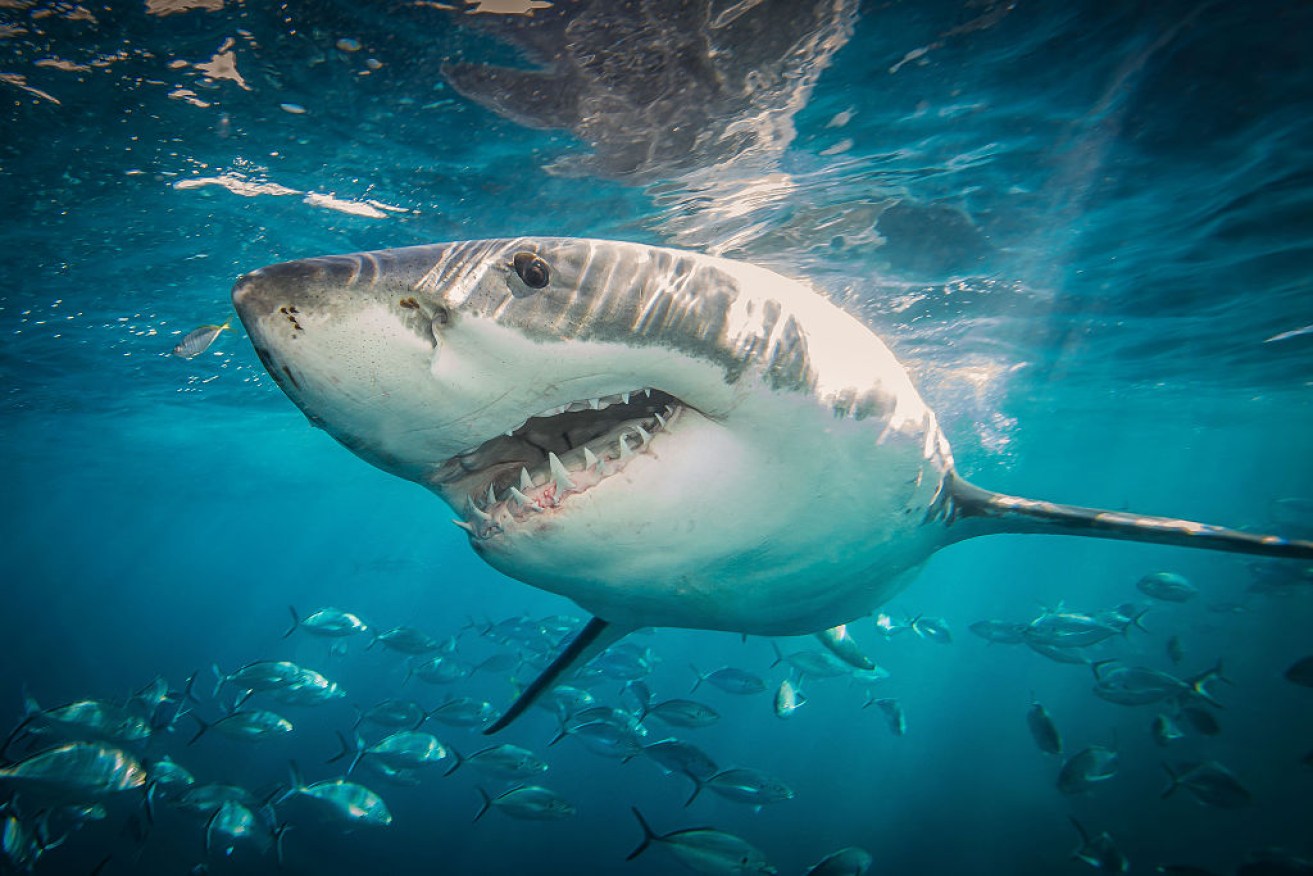The deadly Australian creatures you might meet on your holidays


Local divers suspect the attacker was a great white. Photo: Getty
The schoolgirl was swimming in the shallows in the Whitsundays when the shark struck last September. She lost her leg in the attack.
A day later, a Tasmanian mother of two was bitten, and had 18 hours of surgery. In November, a young Melbourne doctor was also attacked while holidaying in the same area, Cid Harbour. He didn’t survive.
Horrifying shark attacks like these intensify our fears of coming into contact with deadly creatures when we holiday. But should we be afraid?
Experts say better education is the key to sensible precautions.
A 13-year study shows horses, bees and dogs cause more deaths than the creatures we fear most. Here are some more myth-busting facts.
Sharks
Taronga wildlife conservation society’s Shark Attack File shows sharks killed one person in Australia in 2018.
Associate Professor Charlie Huveneers, head of Flinders University’s southern shark ecology group, said three species were considered potentially dangerous: bull, tiger and [great] white sharks.

It’s hard to predict where sharks might strike. Photo: Getty
Staying safe
Associate Professor Huveneers said there were no real warning signs that sharks were about. Some areas use spotters and aerial patrols that, while not foolproof, do offer added protection.
It was also difficult to predict where sharks might strike, he said .
“Cid Harbour was a very safe place to go because there’s hardly been any bites within 20 years. So it went from no bites in 20 years to three bites in a short timeframe. That’s why you can’t really pinpoint where and how.”
Associate Professor Huveneers recommended not swimming near people fishing, or near bait fish. Sharks feed off bait fish such as sardines, which typically form schools.
“Because they’re in large numbers, they’re likely to be attracting a whole range of predators – dolphins, seals, seabirds, but also sharks,” he said.
“All of these recommendations are based on logic, but whether they make big differences is really impossible to say.”
Another commonly explanation offered for shark bites is mistaken identity (a swimmer being mistaken for a seal, for instance).
If you’re really worried, swim in fully enclosed pools or bays or between flags at patrolled beaches.
“Sharks are believed to be more active from sunset to sunrise,” Associate Professor Huveneers said.
Electric personal shark deterrents could also reduce the likelihood of a shark bite, he said.
“Regardless of these precautions, shark encounters are infrequent and shark bites even rarer. People should be more worried about sunburns, strong currents, and waves,” he said.
Sting rays
Associate Professor Huveneers said rays are placid creatures. There have been fewer than five deaths caused by sting rays in Australian waters in the past century.
“Rays are not aggressive and only use their barb when threatened,” he said.
“The only time it can potentially become dangerous is if the barb goes into a key location, like the heart, which is what happened to [wildlife expert] Steve Irwin.”
Staying safe
Keep a respectful distance.
Crocodiles
According to CrocBITE, there were three crocodile attacks on humans in Australia in 2018, with one fatality.
The saltwater croc, the world’s largest living reptile, accounts for most attacks.
Of 233 recorded attacks (including 82 fatal) since 1865, the biggest number of victims (84) were swimming when attacked. Another 38 were fishing. Others were in boats or canoes, camping or sleeping, or standing or walking near the water’s edge.
Distribution maps show salties are found in coastal saltwater and freshwater environments, from Rockhampton, Queensland, throughout Northern Territory to Broome in Western Australia.
Staying safe
Be Crocwise, recommends swimming only in designated safe swimming areas. Don’t assume the absence of a warning sign means it’s safe.
Be extremely vigilant around water at all times, including when fishing, boating or camping, and especially at night. Drag marks on the ground can be a sign crocs are around.
See the full list of safety recommendations at Be Crocwise.
Venomous jellyfish
There are two types to worry about: Chironex fleckeri, a large and lethal species of box jelly, and the irukandji.
The world’s most venomous animal, the fully grown box jellyfish has tentacles that can kill a healthy adult in two minutes, Dr Lisa-Ann Gershwin, the director of the Australian Marine Stinger Advisory Service said.
Fortunately, while stings are common (50-100 hospitalisations a year), most victims survive.
Dr Gershwin said 81 box jellyfish deaths had been confirmed in Australian waters.
Her database shows that, out of about 263,000 stings since 1983, only two deaths have occurred from irukandji.
“Irukandjis make you very, very sick, but don’t usually kill you,” she said.
Associate Professor Jamie Seymour of the Australian Institute for Tropical Health and Medicine at James Cook University, said irukandji are found from Fraser Island on the east coast of Australia, around the country’s northern coastline to Ningaloo reef off Western Australia.
The deadly Chironex fleckeri box jelly is also found in northern Australia – from the tropic of Capricorn north (off Queensland, the Northern Territory and WA).
But, “they come as far south as Gladstone”, Dr Gershwin said. “We know of one case where they’ve come down and stung a girl at Broadbeach on the Gold Coast.”

Jellyfish are widespread in the waters off Australia. Photo: Getty
Staying safe
Experts no longer refer to ‘stinger season’, preferring to say ’higher’ and ‘lower’ risk seasons.
November-May is generally considered peak season for stingers.
“They’re increasingly likely from December to February, but still around in other seasons,” Dr Gershwin said. “There is no month we haven’t found them.”
Box jelly swim beneath the surface, so most people are stung on their legs.
“Boxies come out first thing in morning in calm lagoon areas looking for food, but can be about anytime,” she said. “If you see a lot of pinky coloured small prawns, you probably want to give them a wide berth because there’s going to be boxies chasing them for food.”
Irukandji, which bob on the surface, hit their peak in flat, calm weather. A 2014 study found irukandji stings along the northern Great Barrier Reef coastline were most common in summer (December-February), when south-easterly trade winds drop off.
“You won’t see them,” Dr Gershwin said. “They’re small and transparent, and only a centimetre in body length. The tentacles are a metre long but fine as spiderweb.”
On the days of highest risk, there’s salp (an unrelated planktonic organism that looks like small jellyfish chains) in the water, Dr Gershwin said.
She recommended swimming at beaches patrolled by lifeguards, with stinger nets, and wear full-body swimsuits or wet suits.
More information: Jellyfish App or Stingeradvisor.com

Snakes can kill but – fortunately – are generally also quite shy. Photo: Getty
Snakes
Snake bites are common. However, ABS figures show they caused only 25 deaths in Australia between 2007-2016.
About 100 Australian snake species are venomous, but only 12 can kill people. Among them are tiger, brown, Mulga, death adder and some sea snakes.
Staying safe
Most snakes are likely to slither away if encountered. When hiking, wear sturdy shoes and long pants.
Mosquitoes
With more than 5000 new cases each year in Australia, Ross River virus is our biggest mosquito-transmitted illness, Professor Scott Ritchie of James Cook University’s school of health and medicine, said.
Most infections occurred in northern Australia, from February to May, he said.
“Increasingly, we’re starting to see outbreaks in Victoria and parts of NSW, but it can be found in most areas in Australia where you get a reasonable amount of rain,” he said.
Mosquito populations are common in mangroves and salt marshes as well as inland areas.
Staying safe
Wear protective, white clothing and use repellent and mosquito nets.
Spiders
According to the Australian Museum, the only spiders known to kill humans are the funnel web and redback.
Thanks to anti-venom, apart from a possible fatality in 2016, there have been no confirmed deaths from spider bites in Australia since 1979.
Found all over Australia, the redback builds its web in man-made, shady places.
The funnel web nests in holes in the ground along the east coast from Queensland to Tasmania, and in some areas of South Australia.
Staying safe
Don’t go poking into their habitats without gloves.
Those with persistent critter phobias should holiday in Tasmania. A 2000-2013 study found it was the only Australian state where no deaths occurred from bites or stings.








